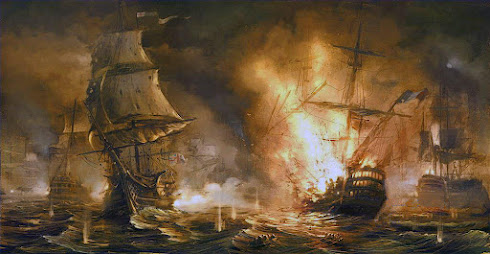THE BATTLE OF TRAFALGAR
1805
Following the brief peace set forth by the treaty of Amiens in 1802 - 03, Napoleon rekindled his grand strategy for the conquest of England. The emperor would first assemble his 150,000 strong Grand Armee in northern France, Napoleon knew this would draw the British Royal Navy into the English channel to protect there coastline.
With the British preoccupied with invasion, Napoleon then ordered French warships under Admiral Villeneuve to leave port and rendezvous with a Spanish squadron under Admiral Federico Gravina in the middle of the Atlantic Ocean.
French spies would then leak this information to the British which would draw the Royal Navy away from the channel, once the English fleet was on an intercept course the French and Spanish vessals would outflank there persuers head north and re enter the channel to support the invasion.
However this plan was instantly thwarted as English spies had informed the British Admiralty of the secret rendezvous at Martinque and placed Admiral Horatio Nelson in command of a British fleet with orders to prevent Villeneuve from uniting with Gravina at all cost.
ADMIRAL HORATIO NELSON
ADMIRAL PIERRE VILLENEUVE
Nelson was one day behind the French fleet as it left the port of Toulon leaving the Medditerainian Sea, sailing past the rock of Gibralter and into the Atlantic. Nelson vigourously persued the French leaving them no time for respite.
So hot on Villeneuves heels was Nelson that when the enemy fleet rendezvoued with the Spanish at Martinque, Villeneuves panicked and tried to escape his persuers by doubling back towards Europe.
However on July 23rd, Villeneuve was intercepted by a British task force under Admiral Robert Calder and was bloodied at the battle of Cape Finisterre off Galicia Spain, having two ships of the line captured and suffering 2,000 casualties.
BATTLE OF CAPE FINISTERRE
Villeneuve now abandoned the idea of putting into the main French naval base at Brest and slipped into the Spanish port of Vigo instead. Nelson arrived and concentrated his fleet of the coast of Spain and blockaded the port in an effort to force Villeneuve to give battle.
With the French squadron moored in Vigo, Napoleon knew he could not launch an invasion of England without the British fleet neautralized, he therefore gave Villeneuve a direct order to sail for the main French naval base at Brest and combine his forces with that of Admiral Ganteaumes.
On August 13th Villeneuve put to sea but was forced by Nelson to take refuge further up the Spanish Coast at the port of Cadiz, where he linked up with a Spanish squadron. Napoleon was furious at Villeneuves unwillingness to give battle and for the next month belittled and humiliated the Admiral pollitically and in the court of public oppinion.
Admiral Villeneuves honor now forced his hand and with a combined fleet of 18 French and 15 Spanish ships of the line put to sea on October 20th. Nelson sighted the enemy squadrons on the morning on the 21st and ordered his fleet to sail towards the enemy line in two columns, the starboard division under Vice Admiral Cuthburt Collingwood led by the HMS Royal Sovereign (15 Ships) and the port column (12 Ships) commanded by Nelson himself aboard HMS Victory.
In the light breeze the British columns moved slowly downwind while the enemy line lay stationary. In naval doctrine of the period, Nelsons ships should have been annihilated by hundreds of broadsides, but Nelson was aware that French tactics dictated they fire high above the waterline at the masts and rigging to imobilize enemy vessals, thus he knew they would be unable to destroy his two columns before they had closed the range.
The British ships took heavy damage as they slowly advanced towards there foe, but once they split the enemy line at 11:45am, they were able to fire diciplined highly efficent double raking broadsides into the bows and stern sections of the enemy vessals which blasted Villeneuves ships into splinters.
It is reported that one double sided broadside from the HMS Victory instantly killed 400 sailors aboard Villeneuves flagship the Bucentaure. By 4:00pm the Franco Spanish line had been completly broken in several places.
It was at about this time during the height of the battle that Admiral Nelson was mortally wounded by a French sharpshooter firing from the rigging of the Redoutable, dying some thirty minutes later at 4:30pm.
DEATH OF ADMIRAL NELSON
Although the death of Admiral Nelson was a crushing blow, the outcome of the battle was beyond doubt as all around the battlefield French and Spanish warships were being cut to peices by disciplined British gunfire.
By 6:30pm the battle had ended in complete British victory, 18 French and Spanish ships had struck their colors and surrendered, 11 heavily damaged others just managed to escape back to Cadiz while four more made off to other ports.
British losses amounted to 458 killed and1,208 wounded. French and Spanish casualties in stark contrast numbered 4,395 killed, 2,541 wounded and 8,000 captured. Britains one sided victory asuared no country would challenge England for supremacy of the Seas and Oceans for the next one hundred years.






This comment has been removed by a blog administrator.
ReplyDeleteThis comment has been removed by a blog administrator.
ReplyDelete